[Chromatography Q & A]: Change into Simple Analytical Condition Using Smaller Volume of Solvent; Change of Column Size from 4.6 mmφ to 3.0 mmφ
This article was written for No. 52 (March 2009), of Analytical Circle.
When the column size is changed from 4.6 to 3.0 mm in internal diameter (I.D.), and the flow rate is reduced by half, the solvent volume can be reduced. Although analysis time is not reduced, such changes are effective in reducing volumes of mobile phase (solvent). Even with columns different in size, if packing agent is same, comparable results can be obtained by using the flow rate changed proportionally to cross section of the column. Neither change of the HPLC system nor examination of the analytical condition is needed.
Figure 1 shows chromatograms in column basic performance tests with columns of 4.6 mm I.D. × 150 mm and 3.0 mm I.D. × 150 mm at a flow rate changed according to cross section of the column. Table 1 compares performance between analysis conditions. Analysis runs at the flow rate of 0.43 mL/min., changed according to cross section, and at that of 0.5 mL/min, half of the flow rate for the original column, both showed comparable performance in terms of number of theoretical plates, peak shape, and column pressure.
-
4.6 mm I.D. x 150 mm, 1.0 mL/min., Injection Vol. : 10 µL 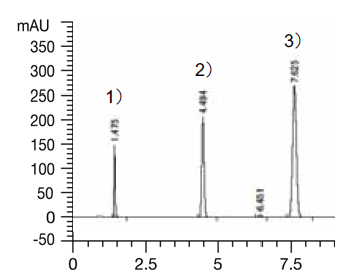
-
3.0 mm I.D. x 150 mm, 0.5 mL/min., Injection Vol. : 5 µL 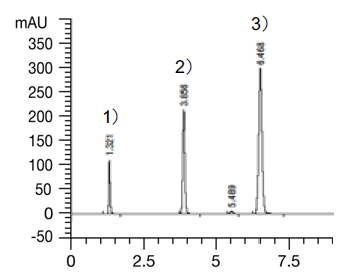
-
3.0 mm I.D. x 150 mm, 0.43 mL/min., Injection Vol. : 5 µL 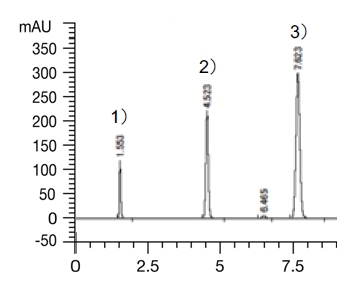
Column : Wakopak® Navi C18-5
Eluent : CH3CN/H2O = 60/40
Temp. : 35℃
Detection : UV 254 nm
Sample : 1) uracil 0.77 mg, 2) benzene 145 µL, 3) naphthalene 20 mg in 100 mL CH3CN/H2O = 60/40 (v/v)
Figure 1. Comparison of column size (basic performance test)
Table 1. Comparison of basic performance between columns under various analytical conditions
| Column size | Cross section (mm2) |
Cross section ratio |
Flow rate (mL/min.) |
Number of theoretical plates (N) |
Peak symmetry (As) |
Column pressure (bar) |
|---|---|---|---|---|---|---|
| 4.6 mm I.D. x 150 mm | 5.29π | 1 | 1 | 16000 | 0.95 | 53 |
| 3.0 mm I.D. x 150 mm | 2.25π | 0.425 | 0.5 | 15300 | 0.94 | 56 |
| 3.0 mm I.D. x 150 mm | 2.25π | 0.425 | 0.43 | 15400 | 0.94 | 53 |
Figure 2 shows representative results of analysis runs on ingredients contained in cold remedy. Tables 2 and 3 compare retention time and area in the above analysis runs (Figure 2). At the flow rate of 0.5 mL/min., analytes were eluted slightly earlier, but the concerned principle for flow rate setting is simple and unlikely to affect precision of the HPLC system, as demonstrated by comparable peak areas from the analysis run using the half-reduced injection volume, allowing simple setting for a new column. In HPLC system available for detailed setting of flow rate and injection volume, the analysis run even with a smaller internal diameter column, if performed using the flow rate and injection volume reduced according to cross section ratio, can provide comparable results to those with the column 4.6 mm in internal diameter.
-
4.6 mm I.D. x 150 mm, 1.0 mL/min., Injection Vol. : 10 µL 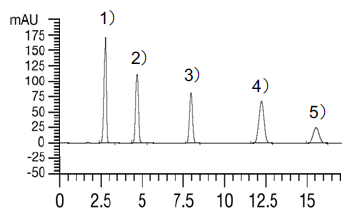
-
3.0 mm I.D. x 150 mm, 0.5 mL/min., Injection Vol. : 5 µL 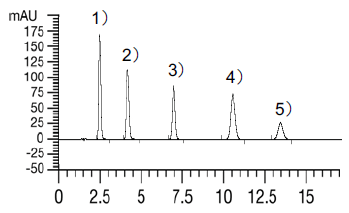
-
3.0 mm I.D. x 150 mm, 0.43 mL/min., Injection Vol. : 5 µL 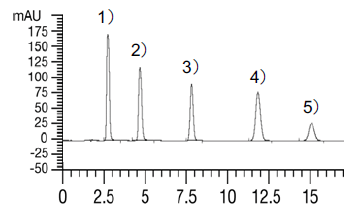
Column : Wakopak® Navi C18-5
Eluent : CH3OH/0.1 % H3PO4 = 30/70
Detection : UV 260 nm
Temp. : 35℃
Sample : 1) acetaminophen 5 mg, 2) caffeine 6 mg, 3) phenol (IS) 20 mg, 4) aspirin 50 mg, 5) ethenzamide 25 mg in 100 mL CH3OH
Figure 2. Comparison between columns different in size (analysis example for ingredients of cold remedy)
Table 2. Comparison of detection sensitivity (peak area) between different flow rates
| Column size | Flow rate (mL/min.) |
Injection volume |
Peak area | ||||
|---|---|---|---|---|---|---|---|
| Acetaminophen | Caffeine | Phenol (IS) | Aspirin | Ethenzamide | |||
| 4.6 mm I.D. x 150 mm | 1.00 | 10 µL | 1656.55 | 1302.92 | 983.97 | 1395.16 | 588.54 |
| 3.0 mm I.D. x 150 mm | 0.43 | 5 µL | 1872.23 | 1503.86 | 1143.28 | 1524.83 | 660.64 |
| 3.0 mm I.D. x 150 mm | 0.50 | 5 µL | 1678.91 | 1316.49 | 996.05 | 1335.33 | 591.86 |
Table 3. Comparison of elution time under different columns size and flow rates
| Column size | Flow rate (mL/min.) |
Injection volume |
R.T. (min.) | ||||
|---|---|---|---|---|---|---|---|
| Acetaminophen | Caffeine | Phenol (IS) | Aspirin | Ethenzamide | |||
| 4.6 mm I.D. x 150 mm | 1.00 | 10 µL | 2.83 | 4.72 | 7.98 | 12.20 | 15.49 |
| 3.0 mm I.D. x 150 mm | 0.43 | 5 µL | 2.81 | 4.75 | 7.87 | 11.86 | 15.07 |
| 3.0 mm I.D. x 150 mm | 0.50 | 5 µL | 2.48 | 4.16 | 6.94 | 10.50 | 13.37 |
If a column of the internal diameter smaller than 3.0 mm is used, a change to the HPLC system suitable for this column size is needed, but a change from the column 4.6 mm in internal diameter to one 3.0 mm, if the column length remains unchanged, would allow use of the same HPLC system with analytical performance kept comparable. Furthermore, although it depends on elution status of analytes, if use of a shorter column does not significantly affect analytical performance, shorter analysis time can be used, which leads to further reduction of the necessary volume of solvent.
For others, a change of solvent, a change in particle size of packing agent from 5 to 3 µm, and use of a smaller column can be effective in reducing necessary volume of solvent. Any change requires examination of the condition. Primarily, trial use of a column 3 mm in internal diameter is recommended.




